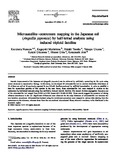Microsatellite–centromere mapping in the Japanese eel (Anguilla japonica) by half-tetrad analysis using induced triploid families

View/
Request this document
Date
2006Author
Page views
399Metadata
Show full item recordCited times in Scopus
Share
Abstract
Genetic improvement of the Japanese eel (Anguilla japonica) can be achieved by artificially controlling its life cycle using recent advances in reproductive biology. In this study, we developed 43 microsatellite loci to confirm Mendelian inheritance at 10 of them as well at 16 previously reported in two full-sib families produced by artificial insemination. In order to establish a base for aquaculture genetics of this species in the near future, these microsatellite loci were mapped in relation to the centromere by half-tetrad analysis using four artificially induced triploid families. The second division segregation frequency (y) of the microsatellite loci ranged from 0.008 to 0.968 (mean ± SD = 0.645 ± 0.298). These results suggest the presence of strong chiasma interference in the eel. Significant differences were observed for the map distances of microsatellite loci between the two isolation procedures. Microsatellites isolated using the enrichment procedure were mapped to various sites starting from the centromere to the telomere, whereas those from the conventional size-selected library showed a tendency to be distributed in the telomeric region.
Suggested Citation
Nomura, K., Morishima, K., Tanaka, H., Unuma, T., Okuzawa, K., Ohta, H., & Arai, K. (2006). Microsatellite–centromere mapping in the Japanese eel (Anguilla japonica) by half-tetrad analysis using induced triploid families. Aquaculture , 257(1-4), 53-67. https://doi.org/10.1016/j.aquaculture.2006.03.011
Subject
Collections
- AQD Journal Articles [1231]

